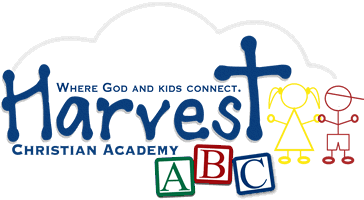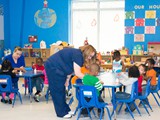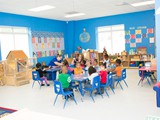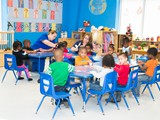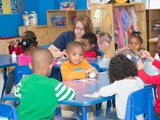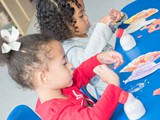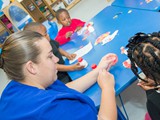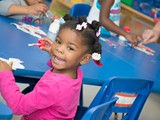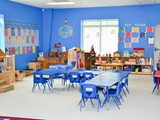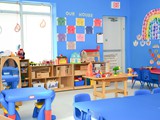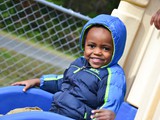At this age, children have fully emerged from solitary to parallel play. Children begin to self-manage their own activities and the classroom becomes child-initiated and teacher-directed. The curriculum is refined and prepares them for a more structured setting. The teachers aid the children through communication and conflict resolutions. Problem solving is an important life skill which allows children to reason and compromise which will set them up with the skills to have successful relationships in the future. In addition to these skills, they are also becoming logical thinkers and can understand the differences in groups of objects. Our teachers will take the time necessary to prepare each child for the next phase of his education career: Pre-K and Kindergarten.
Photo Gallery
- Cognition
- Learning Approach
- Physical Health
- Social Development
Cognition
- Asks “why” questions to show effort at understanding causation.
- Organizes objects by more than one pre-selected characteristic.
- Applies new information or vocabulary to an activity.
- Generates a strategy based on one learning event and extends it to a new learning opportunity.
- Uses symbols or pictures as representation for oral language.
- Engages in complex make-believe play.
- Names numerals up to 20 or more.
- Understands that numbers represent quantity.
- Recognizes the names of some numerals.
- Counts at least five objects in one to one correspondence without assistance.
- Tells what number comes before or after a given number up to ten.
- Estimates size.
- Labels objects using size words.
- Creates, builds, or draws shapes.
- Orders objects from smallest to largest.
- Creates patterns.
- Classifies objects.
- Uses positional words.
- Makes predictions.
- Retells a simple story or event in roughly sequential order.
- Knows first and last name.
- Names address and telephone number.
- Participates in music experiences.
Learning Approach
- Asks others for information.
- Investigates and experiments with materials.
- Uses “Why” to get information.
- Develops personal interest.
- Joins a play activity already in progress.
- Remains engaged in activities for at least 10 minutes.
- Makes up words, songs, or stories.
- Engages in extensive pretend play.
- Tells others about events that happened in the past.
- Works out problems.
Physical Health
- Crawls through a play tunnel or under tables.
- Throws a ball overhand with some accuracy.
- Catches large balls with two hands.
- Kicks a ball forward.
- Gallops with skill.
- Uses various drawing and art materials.
- Cutting skills progress from inaccurate cutting to proper grasp with some degree of accuracy.
- Completes increasingly complex puzzles.
- Writes name.
- Begins to write some recognizable letters or numbers.
- Demonstrates concepts through movement.
- Improves eye-hand coordination.
- Covers mouth when coughing.
- Washes and dries hands independently.
- Takes care of toileting needs and asks for assistance when needed.
Social Development
- Expresses feelings.
- Initiates activities with another child.
- Cooperates with other children, with assistance.
- Negotiates with peers.
- Approaches other children positively.
- States a position with a reason.
- Shows empathy.
- Uses pretend play to explore, practice, and understand social roles.
- Engages in cooperative play.
- Successfully transitions from one activity/ setting to the next.
- Shows concern for fairness.
- Describes own basic physical characteristics.
- Enjoys process of creating. Focuses on the meaning of words rather than grammar.
- Uses sentences.
- Responds appropriately to a request.
- Has a receptive vocabulary of a several hundred words.
- Asks the meaning of unfamiliar words.
- Uses multiple words to explain an idea.
- Speech is entirely intelligible.
- Describes a task.
- Uses past tense.
- Responds to questions with verbal answers or gestures.
- Engages in conversation.
- Tells a short make-believe story, with assistance.
- Begins to draw representational figures.
- Identifies some individual letter in a text.
- Recognizes own printed name.
- Uses pictures to predict a story.
- Identifies major characters in story.
- Imitates common reading activities.


